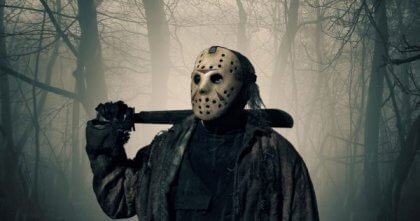There are many ghost movies. In fact, you might even feel that they’re all alike. However, one that certainly tends to stand out is The Others (Amenábar, 2001).
There’s a certain nostalgia to this movie. In fact, it’s influenced by both classic thrillers and horror films. Today, some 20 years after its release, we’re going to look back and see how it managed to connect so successfully with audiences and critics alike.
The Others tells you the kind of ghost story you’ve heard before but from a different perspective. Furthermore, it plays with your perception of reality.
Just a word of warning. This article tells the story of the movie. If you haven’t seen it yet, you might want to stop reading now.
A fortunate production
Today, Alejandro Amenábar is one of the most well-known filmmakers on the Spanish movie scene. However, 20 years ago, this director of Tesis (1996) and Open Your Eyes (1997) was largely unknown, particularly internationally.
The Others marked the turning point in Amenábar’s career. It was also the highest-grossing Spanish movie of its time.
Nevertheless, it wasn’t without its critics. In fact, they frequently compared it to The Sixth Sense (Shyamalan, 1999). However, in reality, the only similarity between the two films was the final twist.
The Others managed to awaken feelings among the viewing public not seen for a long time. Nevertheless, it’s really quite a simple movie. In fact, it revolves around a story that’s been told numerous times. A house, where the living and dead mix together and where the younger people are those most likely to detect the supernatural presences. However, The Others is told from the point of view of the dead.
There’s no need for too many actors or numerous changes of scenery to tell this story. In fact, they probably could’ve made it without too much of a budget. However, Amenábar was lucky. He didn’t have to skimp on any expenses. For this reason, he could afford to give the film the atmospheric touches that shot it to fame.
Tom Cruise showed huge interest in Amenábar’s filmmaking after he saw Open Your Eyes. His admiration for the Spanish-Chilean filmmaker led to him making a new version of Open Your Eyes entitled Vanilla Sky. However, Amenábar refused to direct it. The story didn’t end there, though. In fact, Cruise eventually became one of the producers of The Others. The only conditions that Amenábar laid down were that the movie had to be shot in Spain with his own production team. The rest is history.
Light played an important role
A generous budget is always helpful when making a movie like The Others. However, in truth, a good story is much more important. Furthermore, different people can tell a story, and it’ll never be the same twice. In fact, according to the narrator or its perspective, it can make you laugh, cry, or feel completely indifferent. However, in cinema, there’s no verbal narrator. They convey everything via images.
When you think of the genres of fantasy and horror, you think of particular elements. One of these is darkness. That’s because the fantastic and scary usually happen at night. It’s the time when you feel most vulnerable and unprotected and all your fears come to the surface. In fact, we usually link fear of the dark to the unknown. It forms part of our collective imagination.
They use chiaroscuro lighting in the movie to great effect. This is the kind of artificial light that evokes mystery. Javier Aguirresarobe was the cinematographer. They’ve actually compared him to cinema greats like Stanley Kubrick. Indeed, the way in which he uses dark and light in the film helps to create a unique atmosphere. It keeps the viewer on tenterhooks.
Often, we see light as signifying safety and protection. However, in this movie, the opposite is true. Due to Grace’s children’s illness, the house has to remain dark. In fact, the darkness makes them feel secure. Obviously, this strays completely from the norm. This is reflected in the final twist of the movie when you discover the story isn’t actually about the living.
Nevertheless, light remains to be the bearer of truth. In fact, it’s no coincidence that Mrs. Mills is always seen to be near a lamp or carrying one. Because Mrs. Mills is the bearer of truth herself. She ultimately shows Grace and her children the true facts of the matter, as difficult as it is for them to bear.
The cinematography gives the house an air of unreality. It also feels particularly claustrophobic and isolated and the characters barely mention the outside world. Furthermore, what lies beyond the limits of the house and graveyard is completely shrouded in fog.
It’s no wonder that the biggest revelations in the film are linked to the light. For instance, someone removes the curtains. However, although the children are frightened, their skin isn’t damaged. Also, when the end of the movie comes, they celebrate their “healing”. In addition, the fog disappears.
The light in The Others isn’t a natural kind of light. It’s evocative and envelops you in the terrifying atmosphere. With no special effects, but through camera movements and chiaroscuro, you learn that something strange is happening in the house. That some kind of intruder has destroyed normality.
The keys to suspense
The Others makes its intentions extremely clear right from the opening credits. You know that what you’re about to see is a macabre and fantastical story. In fact, the movie begins with a woman screaming on awakening. Has she had a nightmare? Has something happened before that you don’t know about?
Throughout the film, little Anne says on several occasions that “something happened”. This something clearly happened before Grace’s scream. A scream that, on first viewing, can go unnoticed. However, the director has inserted this scene right at the beginning of the movie to warn the viewer that something terrible has just happened.
You sense the suspense from the very beginning. The movie actually draws on previous sources like The Turn of the Screw. This was a mystery novella by Henry James (1898). There are also echoes of the master of suspense, Alfred Hitchcock. In fact, the mansion itself resembles the one in Rebecca (Hitchcock, 1949). Furthermore, Grace reminds us of Grace Kelly and the several frightened blondes this British actress portrayed in her cinema career.
Grace also portrays the feeling of isolation that we talked about earlier. She seems to want to live in a fantasy situation devised by herself, in order to evade reality. Throughout the movie, you learn that Grace suffers migraines, loves silence, and barely leaves the house. As a matter of fact, she’s trapped in the lie she’s invented for herself. The lie that she created as a defense mechanism to avoid facing the horrible reality.
In addition, there’s a religious element to Grace’s character. She’s a firm believer and can answer any question about the Bible. Grace herself questions nothing. However, the paradox is that, when she learns the truth, she becomes unable to justify her own existence.
Anne, in contrast to Grace, questions the Bible. She also thinks she knows everything about ghosts. Anne is one of the characters that gives the viewer more of a sense of what’s really going on. In fact, she’s the only one who recalls that “something happened”.
The movie addresses the fear of facing reality, death, and the lack of answers to our own existence. Furthermore, despite the passage of time, it still works perfectly. It doesn’t include stereotypical characters or fantastic special effects. Instead, it evokes suspense in the most classic and effective of ways.
Seven of the Most Popular Horror Films of All Times
The post The Others, a Ghost Story with a Twist appeared first on Exploring your mind.













Comments